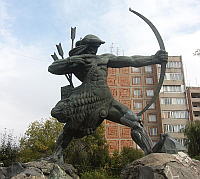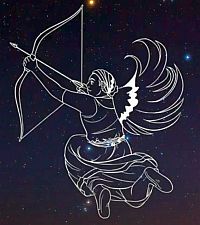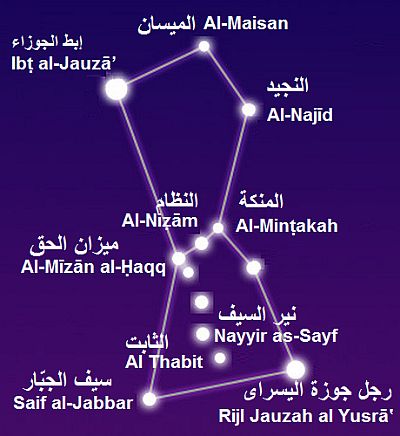Wikipedia
R.H. Allen:
Star Names
Ian Ridpath:
Star Tales
Universe Guide
Sea and Sky:
Constellations
IAU
Map
NASA:
Constellations
|
Wikipedia |
R.H. Allen: Star Names |
Ian Ridpath: Star Tales |
Universe Guide |
Sea and Sky: Constellations |
IAU Map |
NASA: Constellations |


|
|
Myths about the ConstellationOrionPart 2 - Europe and Middle East |
|


 Aurvandil
Aurvandil |
Orion is one of the most prominent and most recognizable constellations in our winter
sky. Located on the celestial equator, the constellation is visible throughout the world. The constellation is named after the hunter Orion in Greek mythology. Throughout Europe and the Middle East, Orion is associated with some of the leading Gods in various ancient cultures. |


|
|
Prehistoric Europe
In 1979, a small ivory tablet was found in a cave in the Ach Valley in Germany's Alb-Danube region. It was dated to be between 32,500 and 38,000
years old, which associates its with the Aurignacian people, Europe's first modern humans.
Source: BBC News, 21 January, 2003 |
 Carvings of a man and a star chart
Carvings of a man and a star chartSource: BBC |


|
|
Viking
In at least one study, Orwandil is identified as the Norse name of Orion with Rigel being one of Orwandil's toes. This refers to
Aurvandil the Valiant a figure from 13th century's
Younger Edda.
Sources: Richard H. Allen: Star Names and their Meanings, |
 Aurvandil the Valiant
Aurvandil the ValiantSource: Viking talizmánok |


|
|
Germanic
There may be some analogies between the Greek legend of Orion and the Scorpion in Germanic mythology, where a mystic sword takes the place of
the scorpion's stinger. In the Ţiđreks saga King
Niđung orders two smiths, Velent and Amilias, to forge an armor, a helmet and a sword. to determine,
which of them is the better smith. Amilias forged a helmet and suit of armor while Velent forged a sword, named
Mimung. When the king puts both to the test, the sword easily cuts through the
helmet and the suit of armor, killing Amilias.
|

|


|
|
Grimms' Fairy Tales
In Sweden and Germany, Orion's Belt was known as
Friggerock (Swedish) or Friggas Rocken (German), meaning
Frigg's or
Freyja's distaff.
|

|


|
|
Hungarian Mythology
From Wikipedia: In old Hungarian tradition, "Orion" is known as (magic) Archer (Íjász), or Reaper (Kaszás). In recently rediscovered myths, he is
called Nimrod (Hungarian Nimród), the greatest hunter, father of the twins
Hunor and Magor.
In other Hungarian traditions, Orion's belt is known as "Judge's stick" (Bírópálca). Source: Wikipedia |
 Hungarian Archer
Hungarian ArcherSource: Pintower |


|
|
Finland
In Finish folklore, Orion is known as Väinämöinen.
Source: Wikipedia |
 Väinämöinen in a painting by
Väinämöinen in a painting byAkseli Gallen-Kallela Source: Wikipedia |


|
|
Macedonia
In ancient Macedonia, Betelgeuse was known as Orach, the plowman.
The belt-stars were seen as the plow's handle.
Sources: Wikipedia and Yuri Berezkin: European Sky in the past |


|
|
Armenia
In Armenia, Orion represents the nation's legendary patriarch and founder Hayk.
Source: Wikipedia |
 Statue of Hayk in Yerevan, Armenia
Statue of Hayk in Yerevan, ArmeniaSource: Wikipedia |


|
|
Hittites
In a Hittite legend from around the same time as the Epics of Gilgamesh (1600 BC), battle-goddess
Anat falls in love with a hunter but accidentally kills him when he refuses to give her his bow.
Source:
Chandra Observatory |
 Bronze figurine of Anat Levant region, 1400–1200 BC Source: Wikipedia |


|
|
Aram
From Wikipedia: |


|
|
Orion References in the Bible
From Wikipedia: |

|
|
In Spain and most of Latin America, the stars of Orion's Belt are called Las tres Marías (The Three Marys).
 In Puerto Rico, the three stars are known as Los Tres Reyes Magos (The three Wise Men).  Similarely, in South Africa, the Belt Stars are called Drie Konings (the three kings).  Sources: Wikipedia, Constellation Guide |


|
|
al-jawza’ - The Arabian Orion
Before abd al-rahman al-sufi and other Arabic astronomers adopted
Ptolemy's constellations, people on the
Arabian Peninsula had their own way to navigate the sky, creating constellations like Lam, Ostriches and
Vulture.
|
 al-jawza celestial-complex presentated by Danielle Adams at
Arab Star Calendar
al-jawza celestial-complex presentated by Danielle Adams at
Arab Star Calendar
|

al-jawza’ is one of the largest of the eleven Arabian Celestial Complexes.
 At the core of al-jawza’ is Orion, but the complete complex reaches out ito six other neighboring modern constellations.  Danielle Adams provides an extensive description of all sections of this celestial complex. She writes: |

Jawza’ was and is a highly celebrated star grouping in the night sky. Like Thuraya, Jawza’ is a fantastically old star name that has been
anthropomorphized over time.
 By the time of Ibn Qutayba (died 889 CE), Jawza’ was a fully articulated human figure, the only one in the Arabian sky. (Thuraya only has a head and two magnificent arms.)  However, it is most likely that the earliest iteration of this asterism consisted of just the three central stars that form a straight line.  Indeed, the name Jawza’ comes from the Arabic root that means something in the center. These three stars are known to us today as the Belt of Orion. The Arabic Star Catalog lists all the individual elements of Jawza’: |
 al-jawza; Source: Youtube:
al-jawza; Source: Youtube:Where Orion is Known as Al-Jawza' |

|
The Lady in the Middle al-jawza’ - الجوزاء Mintaka (δ Ori) Alnilam (ε Ori) Alnitak (ζ Ori)
The Jeweled Belt of Jawza’
The Two Hands of Jawza’
The Two Feet of Jawza’ |
The Head of Jawza’ ra’s al-jawza’ - رأس الجوزاء Meissa (λ Ori) φ1 and φ2 Ori
The Flowing Locks of Hair
The Bow of Jawza’ |
The Front Footstool al-kursi al-muqadam - الكرسي المقدم τ Ori Cursa (β Eri) ψ, λ Eri
The Rear Footstool
The Maidenhead of Jawza’ |

In an ancient Arab legend, Jawza’ was promised to a man named Suhayl, who lived across the river with his two sisters. The sisters were known
Shi’rayan, the Two Shi’ra‘s.
 Nobody knows exactly what happened in the wedding night, but when morning came, Jawza’ was found dead. Jawza’s family sought blood vengeance and Suhayl, fearing for his life fled far to the south, leaving his sisters behind.  One of the sisters later crossed the river to be closer to Suhayl. She was thereafter named ash-shi’ra al-‘abur, the Shi’ra who crossed over.  The other sister stayed behind on the other side of the river and cried and cried so much that she was named ash-shi’ra al-ghumaysa, the little bleary-eyed Shi’ra. |
 al-jawza; Source: Youtube:
al-jawza; Source: Youtube:Where Orion is Known as Al-Jawza' |

The characters of this legend expand the celestial complex beyond the stars of al-jawza’.
To the south of Jawza’ is Suhayl, represented by Canopus (α Carinae), the second brightest
star in the sky; so far to the south that it can only be seen at latitudes south of 35 degrees North.
 Shi’rayan, the two sisters are still on opposite sides of the river (which is the Milky Way).  ash-shi’ra al-‘abur, the Shi’ra who crossed over, is represented by the brightest star in the sky, Sirius (α Canis Majoris) while ash-shi’ra al-ghumaysa, the little bleary-eyed Shi’ra on the other side of the Milky Way is Procyon (α Canis Minoris). |
 Source: Danielle Adams
Danielle Adams kept the legend of Jawza’ and Suhayl alive in two essays:
|

 <
<
|
|
Medieval Islamic Astronomy
Much of the later versions of Orion go back to the original al-jawza’ complex. But
there are also some other interpretations of "the one in the middle."
|
 Colored 1602 copy of
Colored 1602 copy ofal-Sufi's illustration Source: Wikipedia
|

|
Almost all of today's common names of Orion's main stars are of Arabic origin:
|
| Official names derived from Arabic origins are shown in bold. |

The name Betelgeuse (α Ori) has its roots in the Arab words ibṭ al-jawza’ and
yad al-jawza’, both referring to the al-Jauzā constellation. Since al-Jauzā later became Orion, ibṭ al-jawza’ and
yad al-jawza’ are often translated as "Orion's Armpit" and "Orion's Hand," respectively.
 R.H. Allen lists a number of other Arab, Persian and Coptic names, all referring to "Shoulder", "Arm" or "Hand."  Sources: Wikipedia, R.H. Allen
The name Rigel (β Ori) is derived from rijl jawza’ al yusrāʽ, the Left Leg
of the Jawza’;. According to R.H. Allen,
the name Rigel first appeared in 1252 in the Alfonsine Tables.
The name Bellatrix (γ Ori) is also taken from contemporary reprints of the Alfonsine Tables. Tee original Arabic name, first used by 9th century Persian astrologer Abu Ma'shar al-Balkhi was Al Najīd, meaning "the Conqueror." |

|
 Al-Balkhi had the name al najīd originally assigned to Capella (α Aur), but in the 15th century, the name shifted. Timurid sultan and astronomer Ulugh Beg called the star al murzim al najīd, meaning "the Roaring Conqueror" or "the Conquering Lion", which, according to R.H. Allen is "... heralding his presence by his roar, as if this star were announcing the immediate rising of the still more brilliant Rigel, or of the whole constellation."  The Vienna School of Astronomy "translated" the Arabic name to Bellatrix, which is Latin for "Female Warrior," hence again referring to Jawza’ as a woman.  Sources: Wikipedia, R.H. Allen |

There were several Arabic names for Orion's Belt. It was known as al nijād (the Belt),
al Nasak (the Line) and al Alkāt (the Golden Grains or the GoldenNuts).
 Source: Wikipedia The names of the three belt stars are closely related to the "Belt" image:
Mintaka (δ Ori) is derived from the Arabic al minṭakah, which
is another name for "the Belt."
Alnilam (ε Ori) comes from the Arabic al-niẓām, which is a string of pearls.
Alnitak (ζ Ori) is derived from the Arabic an-niṭāq, meaning "the girdle."
|
 Arabic Names of the stars of Orion
Arabic Names of the stars of OrionChart done by the author based on a map by seasky.org |

Saiph (κ Ori) comes from the Arabic saif al jabbar, meaning "sword of the giant."
 Referring to the star's position at the "right leg" of Orion, 17th century Egyptian astronomer al-Muwaqqit called the star rekbah al-jawza’ al yemeniat, the "right knee of the giant."  Source: Wikipedia
Iota Orionis was originally called nayyir as-sayf, "the Bright One of the Sword."
The name Meissa (λ Ori) derived from the Arabic al-maisan, "The Shining One." Originally,
that name was used for the nearby γ Geminorum. Through the transition of Arabic star tables to the
Alfonsine Tables (which were written in Castilian) to the Latin tables
of Renaissance Europe, the name was mistakenly transferred to λ Orionis.
Thabit (υ Ori) is derived from al thabit, which means "the Endurer."
R.H. Allen notes that the name first appeared
in 1835 in the star atlas Geography of the Heavens by
Elijah Hinsdale Burritt. No further details were given.
|


|
|
Orion References in Islam
From Wikipedia:
Sources: Wikipedia and
Beautiful Names of Allah |


 |
Back to Greece, Sumer, Babylon and Egypt | Forward to Asia and Pacific |
 |


|
Back to Star Lore |
Back to Mythology |

Back to Orion Myth |
Back to Space Page |
Back to English |
 Back to Start Page |